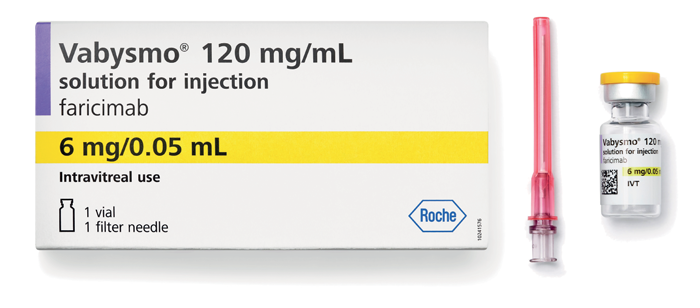
Roche Products Ltd. has commissioned this feature and is responsible for the placement and information provided. For healthcare professionals only.
Neovascular age-related macular degeneration (nAMD) and diabetic macular oedema (DMO) continue to be among the leading causes of vision loss globally (1, 2). One of the latest treatments developed to provide an effective option for clinicians and patients is the first and only bispecific antibody approved for the eye, Vabysmo® (3).
Vabysmo is engineered to target and inhibit two signalling pathways, which are linked to a number of vision-threatening retinal conditions by destabilizing blood vessels, causing new leaky blood vessels to form and increasing inflammation. Dual inhibition of angiopoietin-2 (Ang-2) and vascular endothelial growth factor A (VEGF-A) results in improved anatomical outcomes, including retinal drying (4, 5, 6). Vabysmo is approved in more than 80 countries around the world for people living with nAMD and DMO, with approximately 2 million doses distributed globally, including over 200,000 doses in the UK (7).
“Once faricimab was approved by NICE I adopted it into our service and it’s had a big impact on both patients and our capacity,” explains Aires Lobo, Consultant Ophthalmologist and Clinical Director, Moorfields Eye Unit at Bedford Hospital. “We have been able to treat more patients and extend the time between appointments to 12 weeks after the fifth intravitreal injection for around 40% of the nAMD patients, including both those switching from anti-VEGF therapy and treatment naïve patients.”
Roche’s ever-expanding programme of real-world studies includes more than 8,500 participants in almost 30 countries. These studies are investigating everything from the impact of extended intervals between dosing on vision outcomes, to treatment patterns, to the long-term safety and efficacy of Vabysmo®.
Roche remain committed to transform treatment outcomes in nAMD and DMO. With clinical and real-world data supporting the potential of Vabysmo (7, 8, 9), as well as its nomination for “Best Pharmaceutical Product” in the 2023 Prix Galien USA Awards (10), the future looks promising for retinal diseases.
Date of Preparation November 2023 / M-GB-00015173
References
- Blindness and vision impairment. World Health Organization. Published October 13, 2022. Accessed November 20, 2023. Available at: rb.gy/xrxul8
- Diabetes: vision loss. Centers for Disease Control and Prevention (CDC). Updated December 19, 2022. Accessed November 20, 2023. Available at: rb.gy/fbkauj
- Electronic Medicines Compendium, smPC, Vabysmo (2023). Available at bit.ly/47JIlCV.
- JS Heier et al., “Efficacy, durability, and safety of intravitreal faricimab up to every 16 weeks for neovascular age-related macular degeneration (nAMD) (TENAYA and LUCERNE): two randomised, double-masked, phase III, non-inferiority trials,” The Lancet, 399, 729 (2022). PMID: 35085502.
- CC Wykoff et al., “Efficacy, durability, and safety of intravitreal faricimab with extended dosing up to every 16 weeks in patients with diabetic macular oedema (YOSEMITE and RHINE): two randomised, double-masked, phase 3 trials.” The Lancet, 399, 741 (2022). PMID: 35085503.
- G Querques et al., Faricimab rapidly improves fluid parameters in patients with neovascular or ‘wet’ age-related macular degeneration (nAMD). Poster at: Association for Research in Vision and Ophthalmology (ARVO) Annual Meeting; 2023 April 23-27 Abstract #2185.
- Roche data on file.
- MHRA approves faricimab through international work-sharing initiative Available at: rb.gy/7xio75
- JM Coney et al., “Elevatum study design and rationale: a phase IIII trial of faricimab (VABYSMO) in underrepresented patients with diabetic macular edema,” paper presented at the ASRS Annual Meeting; 28 July – 1 August 2023; Seattle, Washington, US.
- PR Newswire, “The Galien Foundation Announces 2023 Prix Galien USA Nominees for ‘Best Biotechnology Product,’ ‘Best Pharmaceutical Product’ and ‘Best Product for Rare/Orphan Diseases’,” (2023). Available at: prn.to/3Rt7XPw.
